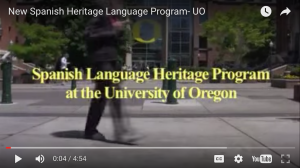Heritage language learners in language classrooms – Anna Mikhaylova
A widely cited broad definition of heritage speakers in the US by Valdés (2001) includes individuals raised in homes where a language other than English is spoken, who are to some degree bilingual in English and the heritage language and, who also have a personal interest or involvement in an ancestral language. Polinsky and Kagan (2007) offer a narrow definition of heritage language as the language which was sequentially first, but may not have been completely acquired due to the speaker’s shift to another language as their dominant means of communication. The latter distinction suggests that, like foreign language learners, heritage speakers may differ in their proficiency levels. Kagan and Dillon (2004) outline the following “matrix” for programs targeting heritage language learners: proper placement; time on task; programmatic rigor; specific instructional materials; an uninterrupted, comprehensive curriculum; instructors trained in heritage language acquisition; a multi-year sequence; consideration of the home/community native speaker environment; and a metalinguistic framework that raises awareness of the importance of grammatical accuracy and register (p.100).
The National Heritage Language Resource Center at UCLA has many useful resources for both teachers and linguists interested in working with heritage language learners. One of the center’s big projects, led by Maria Carreira and Olga Kagan was a national survey of 1732 heritage speakers of 22 different heritage languages across the United States. As a result, the following general profile of an adult heritage language (HL) learner studying the heritage language at the university level was published in 2011. Such a learner (1) acquired English in early childhood, after acquiring the HL; (2) has limited exposure to the HL outside the home; (3) has relatively strong aural and oral skills but limited literacy skills; (4) has positive HL attitudes and experiences; and (5) studies the HL mainly to connect with communities of speakers in the United States and to gain insights into his or her roots.
While some universities do have classes devoted specifically to heritage language learners or even whole programs, like the Spanish Heritage Language Program here at the University of Oregon, more often heritage language learners find themselves in the same classroom with foreign language learners of the same language. 
One of the differences (an assumed advantage) observed for heritage language speakers of various languages over foreign language learners is that the former are exposed to the target language naturalistically from birth in family/community contexts while the latter usually post-puberty and in instructed contexts. From this often assumed definitional difference stem other common observations about heritage speakers being usually stronger in oral skills than in literacy-based reading and writing, having a stronger cultural connection, a larger vocabulary and greater focus on meaning than on form in language use, while second language speakers are believed to have stronger reading and writing skills and metalinguistic knowledge and greater attention to form with noticeably weaker oral fluency. While, unfortunately to date there are not too many empirical studies that test effectiveness of instruction, but those that do find that instruction is useful for both types of learners.
Based on these observations, a number of scholars (Beaudrie, Ducar, and Potowski (2014) among others) have called for different or at least differentiated instructional and research methodology approaches targeting the two types of learners. For example, Kagan and Dillon (2009) suggest that macro-based (top-down) and discourse based teaching is more suitable for HL learners in instruction of grammar and vocabulary than the bottom-up grammar/vocabulary to function teaching often used in L2 contexts. Carreira & Kagan (2011) argue for a community-based curriculum, which incorporates materials and types of activities that help learners connect to their experiences in the U.S.
